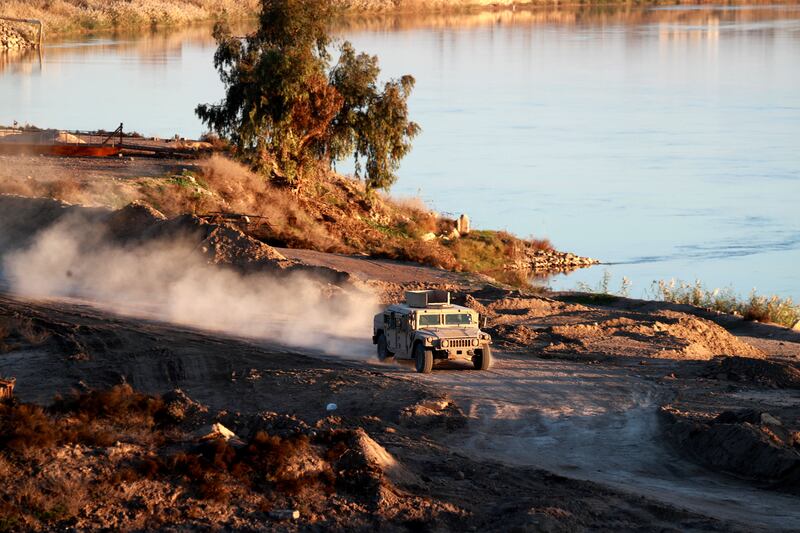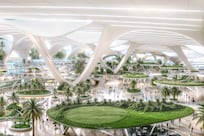Live updates: Follow the latest news on Israel-Gaza
A parched corner of Syria near the border with Iraq has become a launch pad of increased attacks against American forces since the war in Gaza started on October 7.
The area is a crucial supply line in Iran’s ‘unity of front’ strategy. The goal, announced by Iranian President Ebrahim Raisi in Damascus in May, is to link Tehran’s allies in the Middle East in attempts to defeat Israel.
In the last four weeks, there have been scores of missile and drone attacks by pro-Iranian groups on American bases in eastern Syria, as well as in Iraq.
The violence remains calibrated by Iran to serve as a “pressure tool”, so Washington can recognise Tehran’s interests in any post-Gaza war scenario, Syrian political commentator Wael Alwan told The National.
“The US administration is trying to avoid an unwanted confrontation, especially with the presidential elections next year. But it doesn’t want to appear succumbing to Iranian pressure,” he said, referring to US retaliatory strikes on Iranian targets in east Syria.
The US intervened militarily in Syria in 2014, setting up Kurdish-dominated forces to counter ISIS.
Militia spread
The Euphrates River divides the US and its rivals, with American forces to its east, where most of Syria's oilfields are located, and Iranian and Russian forces mainly to the west.
One exception is a US exclusion zone in the desert area of Tanaf, to the south-west of the river.
While there are Iranian forces near the zone, Tehran's main military presence, often through forces supervised by the Islamic Revolutionary Guard Corps, is concentrated in areas closer to the Euphrates River.
The closer the river meanders towards the border with Iraq, especially in the crossing area of Albu Kamal, the more common Iranian positions are.
The pro-Iranian militias, as well as members of Al Quds Force, an IRGC unit tasked with training and equipping Tehran's allied groups, have established positions in residential and commercial districts, schools and other educational compounds.
They also have bases near grain silos and farms, as well as in one oilfield, and a landfill, according to Kurdish sources, the Syrian opposition and American officials.
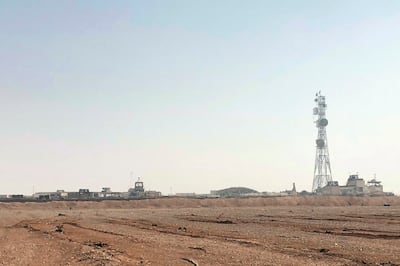
US forces attacked '57 times'
Over the last 30 days, US forces in eastern Syria and Iraq have been attacked 57 times.
A US defence official said that most of the attacks were “successfully disrupted by our military”, and failed to hit their objective.
The last recorded strike was on November 13, when a multi-rocket attack was launched against Mission Support Site Euphrates, near the Conoco gasfield. There were no casualties or “damage to infrastructure,” an official said.
Other targets included the Rumalyn Landing Zone, near Syria's largest oilfield, a base in Shudaddi in Al Hasakah, the Site Green Village, near the Omar oilfield and Al Tanf garrison.
The US is thought to have around 900 soldiers deployed in Syria, often co-located with Syrian Kurdish allies in small military outposts.
Syria used to export 300,000 barrels of oil a day before the 2011 revolt against the Syrian regime, with areas that are now in the US's control zone accounting for most of the production. Current oil outputs are about one-third of its pre-civil war levels.
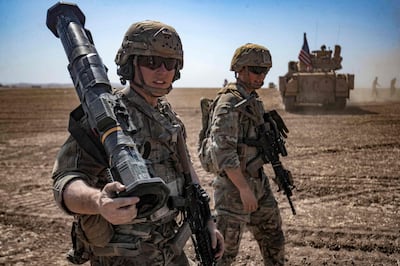
Multi-ethnic force
The pro-Iranian militias in the east are ultimately supervised by Al Quds Force, which had deployed an array of Lebanese, Iraqi, Afghan, Pakistani and local Syrian militia in the area.
The most trusted Iranian partner in the area and the rest of the Middle East is Hezbollah, the powerful Lebanese Shiite group whose militia influenced pro-Iranian groups elsewhere.
Hezbollah set up Al Baqir Brigade, a militia of Sunni tribesmen from Aleppo who were transferred to the east after Aleppo fell back to the control of the Syrian regime in late 2916, following the Russian bombardment of rebel-held parts of the city.
Iraqis comprise the bulk of the 7,000 or so pro-Iranian militiamen in the east.
Among the Iraqi militia in Syria's Euphrates River Valley are Asaib Ahl Al Haq, an offshoot of the Mahdi Army formed by cleric Moqtada Al Sadr. Asaib Ahl Al Haq’s leader Qais al Khazali was a student of Mr Al Sader's late father Mohammed Sadeq Al Sadr, a prominent Shiite cleric who was killed during Saddam Hussein’s rule.
In 2020, Kataib Hezbollah's leader Abu Mahdi Al Muhandis was killed alongside IRGC Quds Force commander Qassem Sulaimani in a drone strike near Baghdad. Since then, Iran and the group have vowed revenge, despite killing at least two US soldiers and losing many of their fighters in tit-for-tat violence.
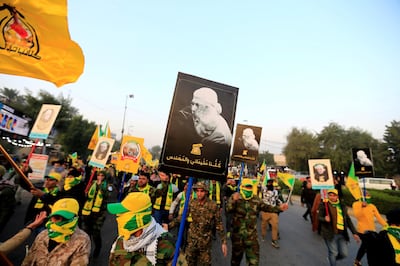
There are also units which originally attacked US forces in Iraq in 2004 and adopted rhetoric similar to Tehran's demonisation of the US. Also present is Harakat Al Nujaba, which was formed in 2013 in Iraq to fight alongside Mr Al Assad’s loyalists in Syria.
The group is seen as one of the most ideological and sectarian-driven Shiite militias in Syria and is a main recruiter of foreign fighters to the country.
Other early Iraqi Shiite incomers to Syria who had spread to the east are Liwa Abu Al Fadhal Al-Abbas and Kataeb Sayyed Al Shuhadaa, which were deployed originally to protect Shiite shrines in Damascus.
Mr Alwan doubts that the balance of power in favour of Iran in the east would change any time soon.
He said that if Washington was serious about countering Tehran in the region, it “would not have let Iran expand to this degree to begin with”.
Additional reporting by Tom Watkins in Washington.
